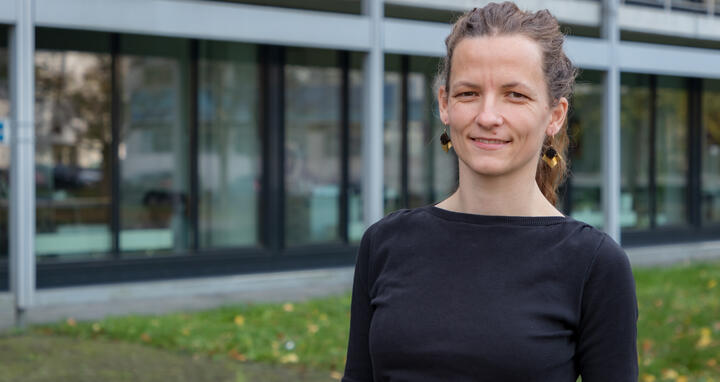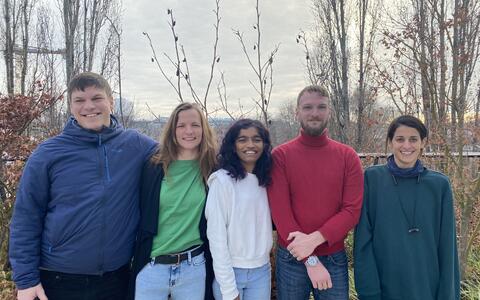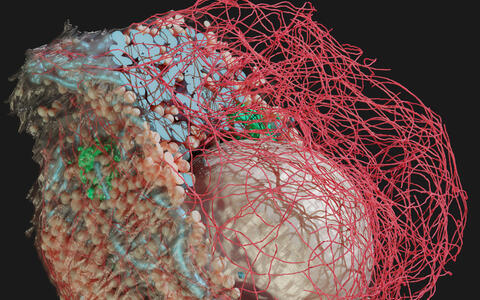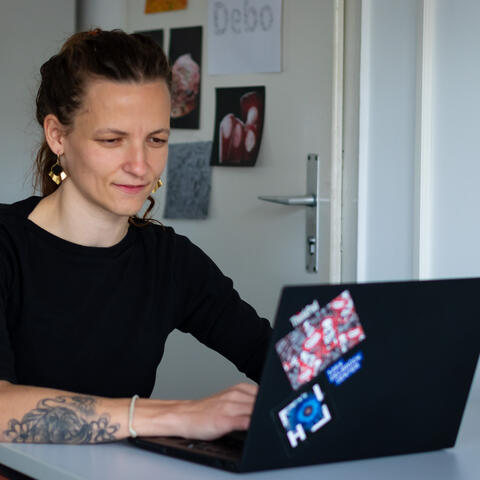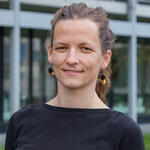Pixels with stories to tell
I want to create societal value with my work at the Max Delbrück Center. That idea really bolsters me in my role as platform leader.
The servers of the Helmholtz Association’s 18 research centers contain a treasure trove of information. Anyone who knows how to “mine” the thousands of gigabytes of image data stored there can tell many a fascinating scientific story. At least that is the view of Deborah Schmidt, the new head of the Image Data Analysis Platform at the Max Delbrück Center. It was with this goal in mind that she came to Berlin two years ago as a research software engineer in Dr. Kyle Harrington’s team. The team develops algorithms and other digital tools for processing and analyzing image data. After Harrington moved to the US to join the Chan Zuckerberg Initiative, the technology platform was without a head for some time. Schmidt took over this position in October of this year and now leads a team of six.
A central point of contact
The team "Image Data Analysis" f.l.t.r.: Leo Epstein, Deborah Schmidt, Madhu Nagathihalli Kantharaju, Jan Philipp Albrecht, Dr. Ella Bahry (not on the picture: Lucas Rieckert)
Schmidt’s platform sees itself as one of three service units of Helmholtz Imaging, an Association-wide initiative based at three collaborating centers: the German Electron Synchrotron (DESY), the German Cancer Research Center (DKFZ), and the Max Delbrück Center. Researchers across the Helmholtz Association can receive free support with imaging-related matters and can network with each other. In the service units, software engineers develop solutions for problems large and small – especially solutions that use imaging techniques to advance scientific research in an interdisciplinary way. The Berlin unit focuses mainly on image analysis and visualization, with a special emphasis on the usability and reproducibility of research at the software level.
Schmidt’s team provides guidance on how to use existing software to do things like removing disturbing “noise” from an image, or they build new tools from scratch. The image of an insulin-producing pancreatic beta cell is a good example: A computer program learned what a beta cell might look like and reconstructed it in 3D for the first time. Schmidt helped devise the strategies needed to do this, using data from an imaging technique that employs ion radiation. Her team is now working to turn these strategies into a user-friendly method so that other researchers can benefit from it. The idea behind the service units is that the solutions that emerge from the collaboration between the technology platform and the research groups can be shared in a user-friendly way across – and beyond – the Helmholtz Association.
3D visualization created by Deborah Schmidt: A beta cell with insulin secretory granules (light orange), mitochondria (blue), nucleus (white) and microtubules (dark orange).
Although two PhD students in the group are carrying out their own research projects at the Max Delbrück Center, the platform’s work – unlike Professor Dagmar Kainmüller’s Science Unit, which is also funded by Helmholtz Imaging – is geared toward supporting the research of other scientists. “My main background isn’t in basic research,” says Schmidt, who is a trained media computer scientist. She previously worked for several years as a software developer, planning and building interactive installations for museums and trade fairs, where she specialized in human computer interaction and open source development. “That was much more applied,” she says. “I want to create societal value with my work at the Max Delbrück Center. That idea really bolsters me in my role as platform leader.”
Creating knowledge for society
Deborah Schmidt has previously worked for four years as a research software engineer at the Max Planck Institute for Molecular Cell Biology and Genetics in Dresden. She was a core contributor for Fiji, a popular scientific image data analysis software, and has developed user friendly plugins for denoising and labeling.
Materials researchers, environmental scientists, or biomedical researchers can use a helpdesk to submit requests regarding data obtained at the microscopic level, from an organism, or even through satellite imagery. The projects that Schmidt feels passionate about are those that enable an exchange between science and society and address real problems faced by citizens. “Knowledge transfer is not only valuable for businesses, but can also empower people to better understand and influence their environment,” she says, stressing that images are a valuable tool in this context. She is very open to citizen science and frugal science, the latter of which is a concept that aims to produce highly effective but low-cost, easy-to-use innovations. Going forward, she hopes to be able to support such scientific work at Helmholtz Imaging.
Text: Christina Anders
Further information
- All of Helmholtz benefits from Helmholtz Imaging
- The Big Picture
- Professorship for Dagmar Kainmueller
- Helmholtz Imaging Website
- Helmholtz Imaging Best Scientific Pictures
- Travelling exhibition: Best scientific pictures at the Max Delbrück Center
- Press release by TU Dreseden about the 3D reconstruction

